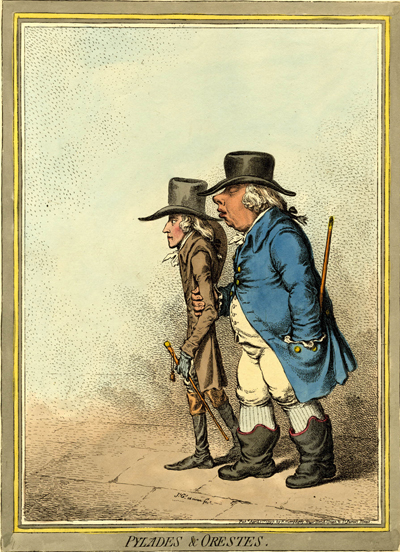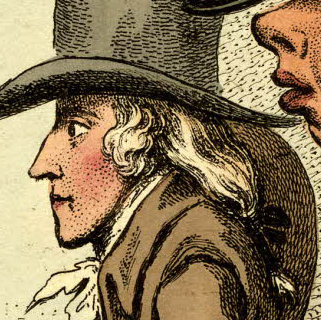Pylades & Orestes
In Greek mythology, Pylades is best known for his love for and devotion to his cousin Orestes. According to Lucian in his Amores, Pylades stood by Orestes
when condemned, nor did they limit their tender partnership to the bounds of Greece, but sailed to the farthest boundaries of the Scythians—the one sick, the other ministering to him.
Gillray picks up the general outlines of this story, portraying William V, the Prince of Orange, as Orestes and his private Secretary, Count Nassalin, as the devoted Pylades. The Prince had been ousted from his position as Stadtholder in the Netherlands by the Batavian revolution of January 1795, fleeing to the safety of Britain in a lowly fishing boat. Nassalin must have joined the Prince in exile some time after that. So here he is, like Pylades, ministering to the former Stadtholder in his illness.

© Trustees of the British Museum
Among other problems, the Prince seems to have suffered from some form of narcolepsy. In Bell's Weekly Messanger for August 14, 1796, we hear that
The Prince of ORANGE is now on a general tour for a month or six weeks, by advice of the faculty, in hopes to give a turn to that somnolectic disposition, which has been rapidly increasing for several months.
And according Sir Nathaniel Wraxall's Historical Memoirs of his Own Time published in 1815, this "constitutional somnolency" only increased with the progress of age.
But, as Wraxhall makes clear, unlike Orestes, the Prince of Orange was not a tragic figure:
he neither inspired public respect nor excited private regard. . . . In vigour, ability, or resources of mind, such as might enable him successfully to struggle, like William the Third, with difficult or tumultuous limes, he was utterly deficient. If William the Fifth had possessed the energies of that great prince, we should neither have been engaged in war with Holland, as happened towards the close of 1780, nor would the stadtholderate have been overturned in 1795, and the Seven Provinces, which successfully resisted all the power of Philip the Second, have ultimately sunk into an enslaved province of the Corsican ruler of France.
So Gillray's portrait is more humourous and pathetic rather than tragic—a caricature of a fat and ugly man shambling along almost unconsciously down Bond Street with the assistance of his tiny, almost effeminate, secretary.
NOTE: The British Museum describes the Prince's secretary as "hunchback." But, as we can see from the detail below, Gillray seems to have added the hump in a hurried afterthought. The secretary's hair, tied back with a black ribbon, falls down behind him upon what would be a normal-looking back. The hump is then added unconvincingly behind the queue and somehow outside Nassalin's jacket—a rare example of carelessness by Gillray.

© Trustees of the British Museum
A preliminary sketch of Pylades & Orestes can be found in the New York Public Library.
Sources and Reading
- Commentary from the British Museum on Pylades & Orestes.
- "Pylades," Wikipedia
- "Orestes," Wikipedia
- "William V, Prince of Orange," Wikipedia
- Sir N. William Wraxhall, Historical Memoirs
- Thomas Wright and R.H. Evans, Historical and Descriptive Account of the Caricatures of James Gillray #433
- Thomas Wright and Joseph Grego, The Works of James Gillray, the Caricaturist; With the History of His Life and Times p. 229
Comments & Corrections
NOTE: Comments and/or corrections are always appreciated. To make that easier, I have included a form below that you can use. I promise never to share any of the info provided without your express permission.